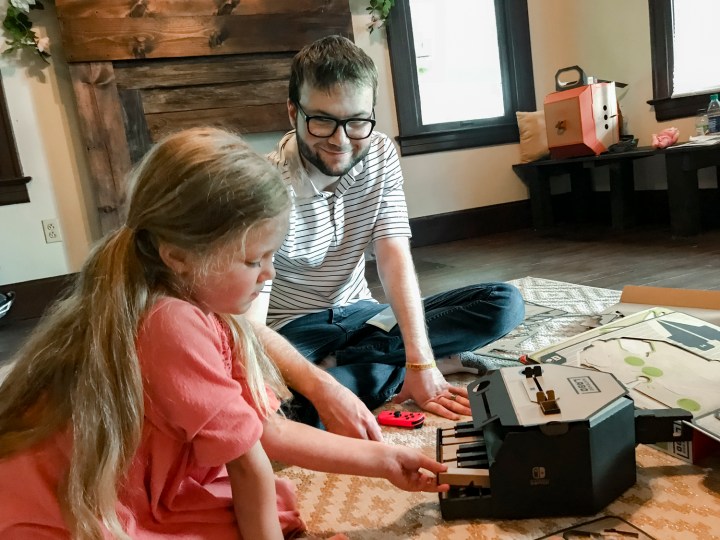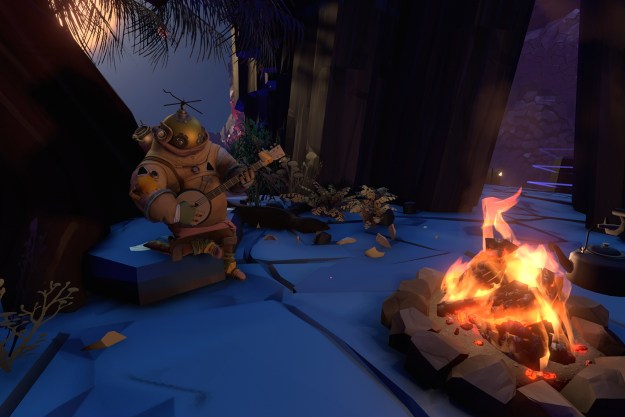
When Nintendo revealed the first trailer for Nintendo Labo in January, I thought it could be a fun experience for my seven-year-old daughter that would also slyly work as a teaching tool. I’m always on the lookout for experiences that can be both fun and educational, and Labo appeared to be just that: A novel arts and crafts kit that tasks users to build cardboard controllers called Toy-Cons, then wield them to play some fun minigames.
Since Labo’s launch last week, my wife, daughter, and I have put together a cardboard fishing rod, motorcycle, piano, robot, and RC car. We’ve had a blast and watching her build them makes me think my daughter could have a real knack for engineering down the line, but I’ve also come away with something I hadn’t anticipated. Nintendo Labo pushed me to exercise parental restraint, even when all I wanted to do was lend my knowhow and guide my daughter through the task at hand.
Here let me just get that for you
No parent likes watching their child struggle. It pains me to see my daughter frustrated when everything isn’t fully clicking. Sometimes that struggle may be beneficial, though. If I constantly hold my daughter’s hand and make every activity a cakewalk, I’m depriving her of an opportunity to safely learn self-reliance and problem-solving skills, lowering her resolve and paving a road to further frustration when we aren’t around to help.
Labo’s immaculate design and incredible level of detail found in its interactive instructions certainly helped eliminate a lot of her difficulties.
Out of the gate, my daughter showed that she could make the Toy-Cons, but not without some missteps, especially when it came to working with smaller pieces requiring many folds. Labo’s immaculate design and incredible level of detail found in its interactive instructions certainly helped eliminate a lot of her difficulties. Each step is exhaustively demonstrated on screen, which makes it hard to get tripped up. That said, while older kids and adults likely only have to see each step once (or not at all when you get in the swing of a build), that likely changes when you have a young child working through the build.
For my daughter, the biggest hurdle wasn’t executing the steps properly, but having the perseverance to rewind, watch the step again, and get it to click. Initially, I found myself wanting to finish what my daughter started, quickly turning the series of creases she made into a finished structure. And I did just that, multiple times while building the repetitive tiny piano keys. At first, she didn’t seem to mind my significant contributions. All seemed to be going well.
I convinced myself that stepping in would both save time and preserve her interest. I worried that as the process became more laborious, she would want to move onto another activity, feeling defeated for messing with the same piece of cardboard on loop for five minutes.
Besides the RC car, each Toy-Con takes more than an hour to build, and the intricate ones, such as the piano, can eclipse the three hour mark. With her, the build times ballooned even more. If you have young kids, you know their attention span is fleeting: Keeping my daughter engaged for multiple hours while following detailed instructions? That’s a challenge. I thought that if I helped her move through the steps faster, she would remain excited about these quirky cardboard toys long enough for us to actually get to playing.
Surprisingly, to me at least, the opposite happened. Each time I folded a piece for her, she promptly asked for it back and volunteered to do the next step. The more I helped her, the less interested she became. I didn’t realize that my helping was hurting her until she eventually started to wander around the house while I quickly put together yet another piano key. She was bored, not of the activity, but of me interrupting her process.
Freedom through constraints
It’s rare to see my daughter so invested in a “game” that has such a stringent ruleset. When she builds LEGO, she does it freestyle. When she makes crafts, she likes to put her own unique spin on it. She’s a free spirit who doesn’t like it when rules bog down her creativity. Yet, she wanted to follow the steps. All of them, or at least most of them, on her own, even when they challenged her.
Over time, though, I was less quick to step in for the assist when she looked puzzled.
Building the Toy-Cons is not a creative endeavor. Every bit of cardboard has a designated spot. No rule-breaking allowed. I’m still not entirely sure why she showed such an interest in following the rules, with Nintendo Labo. I imagine the feeling of building something herself that would be used to play a video game compelled her the most. Again, I also credit Labo’s superb instructions, which allowed her to use trial and error, and eventually lead her to the correct solution.
This is not to say that I didn’t need to help her. There were a few steps that were simply beyond her reach, particularly those that required tying knots into string, fastening grommets, and pieces with many tiny folds and tabs. Over time, though, I was less quick to step in for the assist when she looked puzzled. And I could tell she appreciated that because she would say, “I got it, daddy.”
Trust the process
Now that she’s playing with Labo and the Toy-Cons, I get the feeling that she has been enjoying cardboard fishing, racing, and playing the piano because she’s using the devices she built herself. She told her friends at school that she might be an engineer when she grows up. There’s pride in completing tasks yourself: Each and every time she correctly built a piece on her own, I saw it. And when it took her multiple tries, rewinds, and more than a bit of frustration? She was even prouder.

Sometimes it’s hard to tell when to help and when to let her sit and think until the lightbulb turns on. I don’t like to see her struggle, but watching her succeed was worth it, and makes me think I shouldn’t be so quick to foresee failure. She’s capable of far more than I probably even realize, and that inspires me to believe she can do anything she sets her mind to.
Editors' Recommendations
- World of Goo 2 might just be the Nintendo Switch’s next must-own co-op game
- Mother 3 is finally on Nintendo Switch … but only in Japan
- Everything announced at February’s Nintendo Direct Partner Showcase
- 6 Nintendo series that still haven’t made an appearance on the Switch
- 2023 gaming report card: how did PlayStation, Xbox, and Nintendo score?






